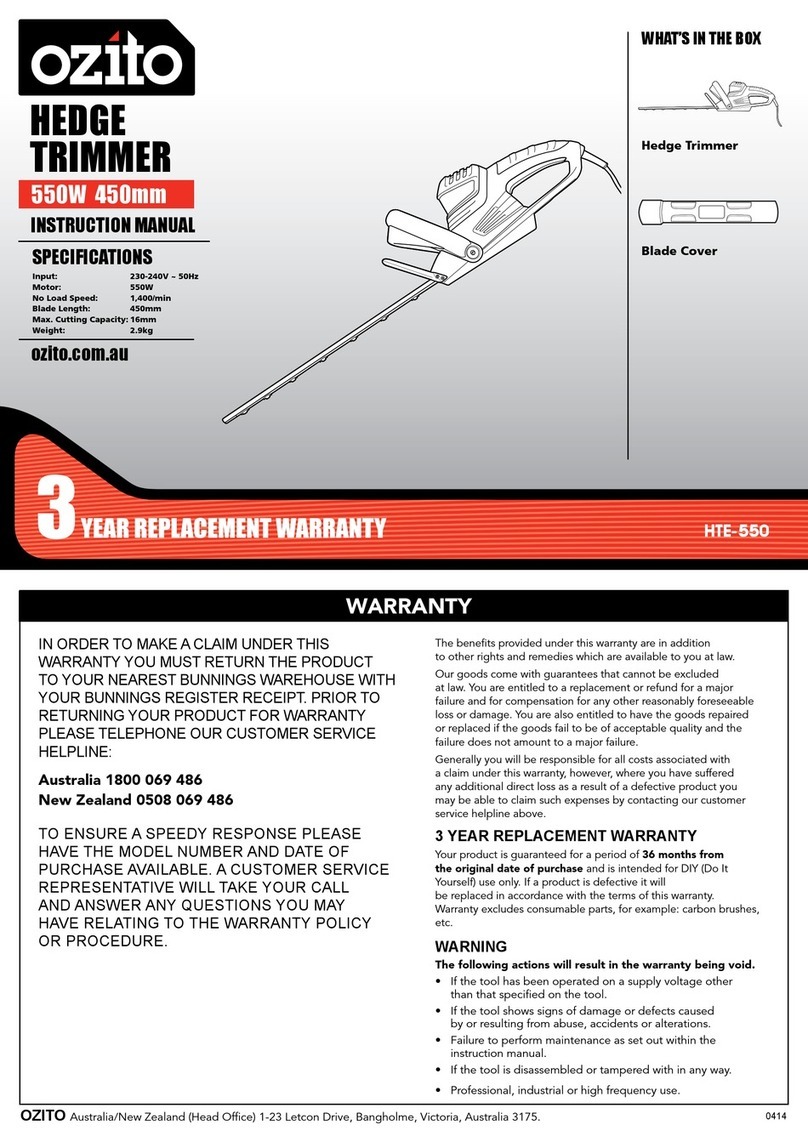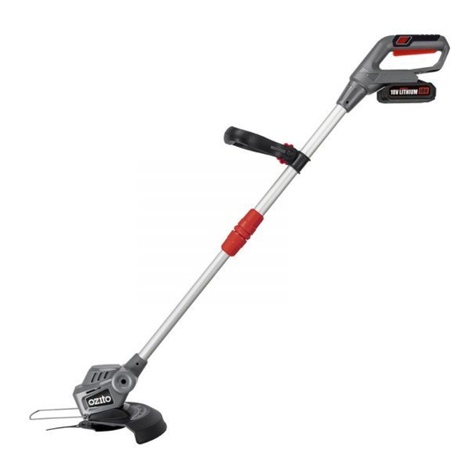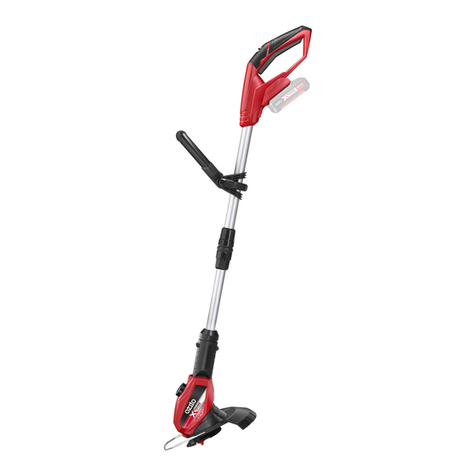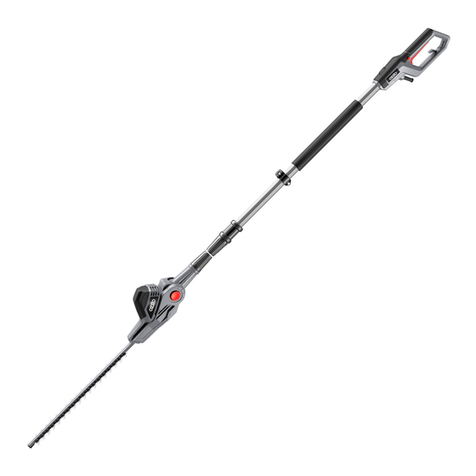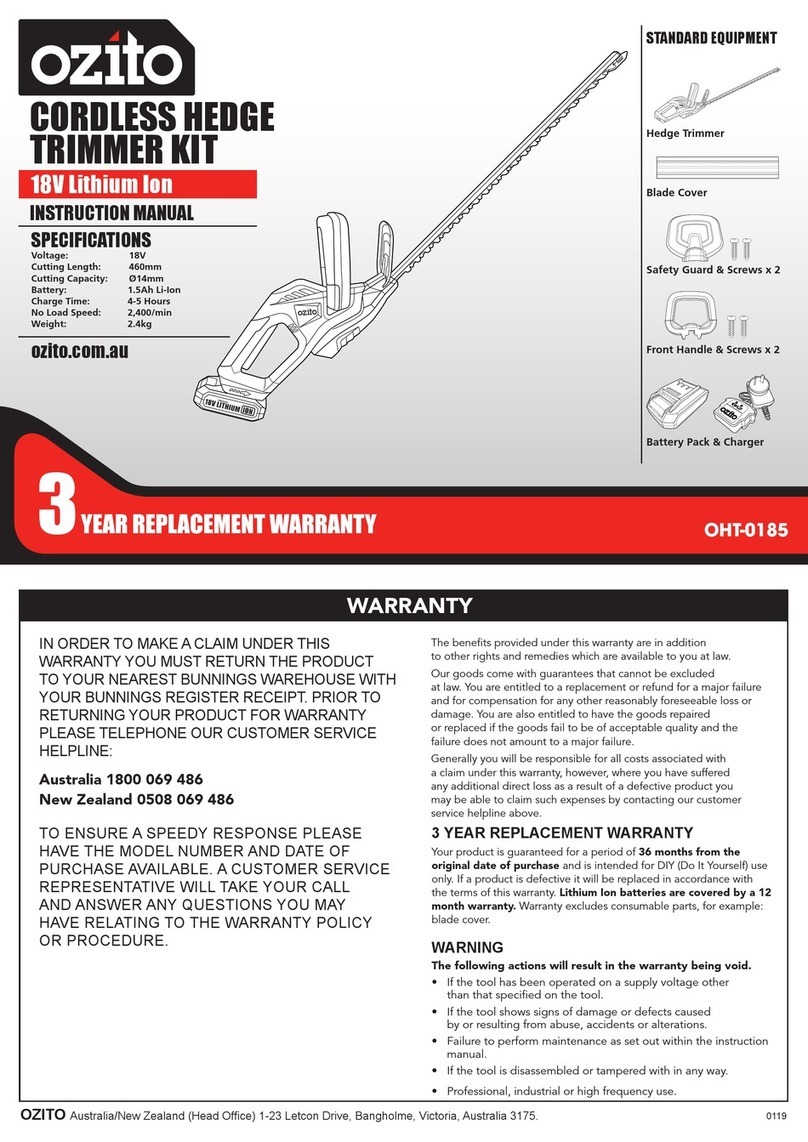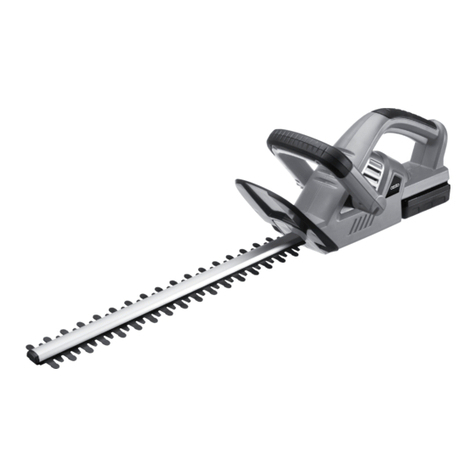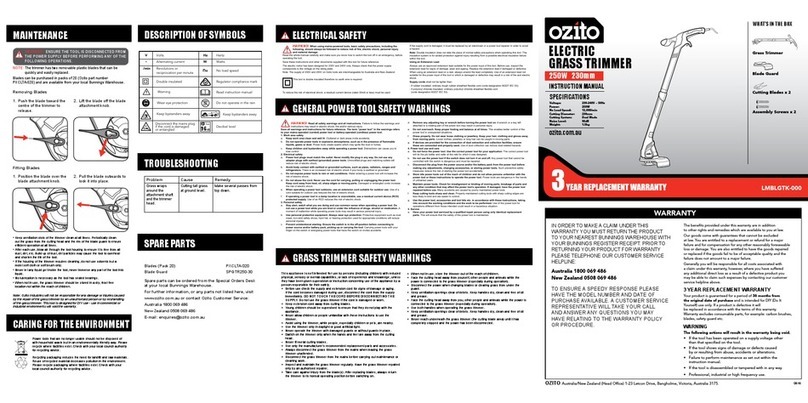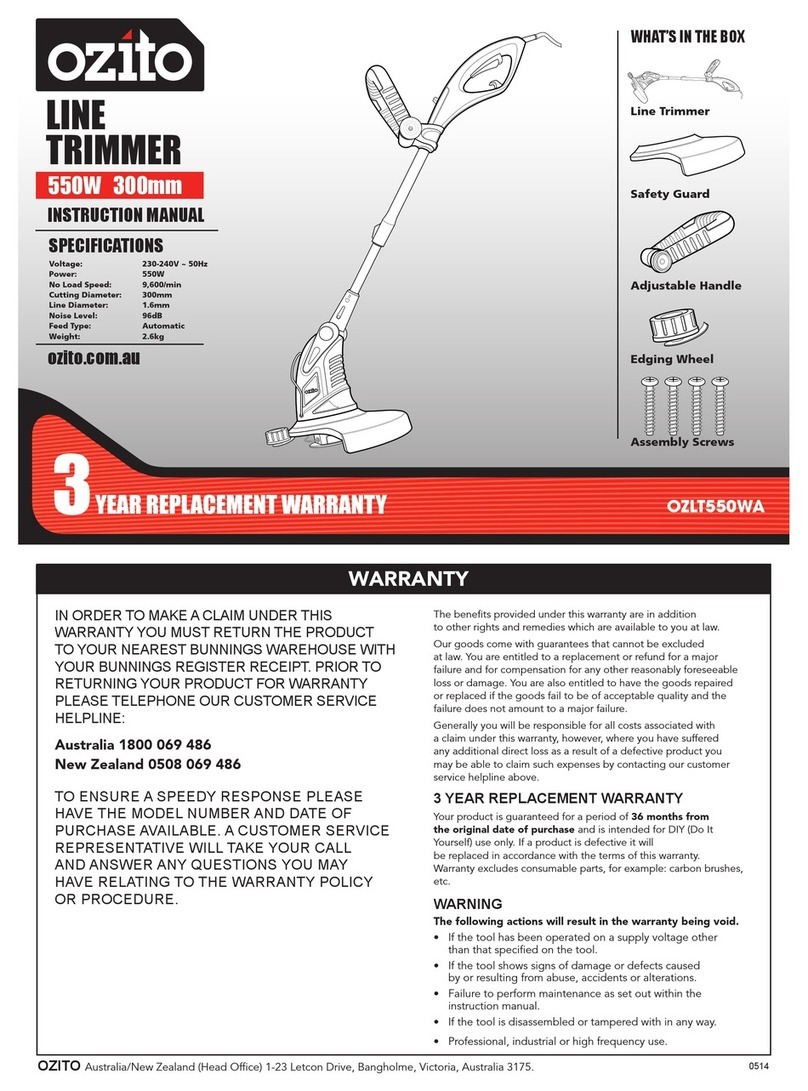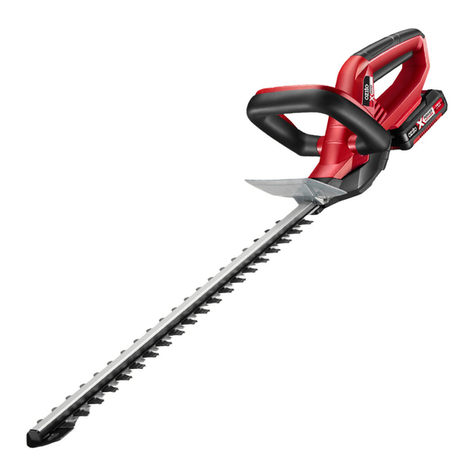GENERAL POWER TOOL SAFETY WARNINGS
ELECTRICAL SAFETY
WARNING! When using mains-powered tools, basic safety precautions, including
the following, should always be followed to reduce risk of fire, electric shock, personal
injury and material damage.
Read the whole manual carefully and make sure you know how to switch the tool off in an emergency, before operating the tool.
Save these instructions and other documents supplied with this tool for future reference.
Please Before you connect the charger to the mains supply make sure that the data on the rating plate are identical to the mains data.
This tools charger is double insulated therefore no earth wire is required.
If the supply cord is damaged, it must be replaced by an electrician or a power tool repairer in order to avoid a hazard.
Note: Double insulation does not take the place of normal safety precautions when operating this tool. The insulation system is for
added protection against injury resulting from a possible electrical insulation failure within the tool.
The power supply for this products charger should be protected by a residual current device (rated at 30mAor less). A residual current
device reduces the risk of electric shock.
Danger! Read all safety regulations and instructions.
Any errors made in following the safety regulations and instructions may result in an electric shock, re and/or serious injury. Keep all
safety regulations and instructions in a safe place for future use.
The term “electric tool” used in the safety instructions refers to electric tools operated from the mains power supply (with a power cable)
and to battery operated electric tools (without a power cable).
1. Workplace safety
a) Keep your work area clean and well illuminated. Untidy or unlit work areas can result in accidents.
b) Do not operate the electric tool in an environment where there is a risk of explosions and where there are inammable
liquids, gases or dust. Electric tools produce sparks which could set the dust or vapours alight.
c) Keep the electric tool out of the reach of children and other persons. If there is a distraction, you may lose control of the
appliance.
2. Electrical safety
a) The connector plug from this electric tool must t into the socket. The plug should never be altered in any way. Never use
adapter plugs together with earthed electric tools. Unaltered plugs and correct sockets reduce the risk of an electric shock.
b) Avoid bodily contact with earthed surfaces such as pipes, heating, ovens and fridges. The risk of electric shock is increased if
your body is earthed.
c) Keep the tool out of the rain and away from moisture. The ingress of water into an electric tool increases the risk of an electric
shock.
d) Do not use the cable to carry the electric tool, to hang it up or to pull it out of the socket. Keep the cable away from heat, oil,
sharp edges and moving parts of the appliance. Damaged or entangled cables increase the risk of an electric shock.
e) If you are working outdoors with an electric tool, only use extension cables which are designed specically for this purpose.
Using specially designed outdoor extension cables, the risk of electric shock is reduced.
f) If operation of the electric tool in a damp environment can not be avoided, use a earth-leakage circuit-breaker. The earth-
leakage circuit-breaker reduces the risk of an electric shock.
3. Safety of persons
a) Be careful, watch what you are doing and use an electric tool sensibly. Do not use the tool if you are tired or under the
inuence of drugs, alcohol or medication. A moment of inattention when using the electric tool can result in serious injuries.
b) Wear personal protection equipment and always wear safety goggles. Wearing personal protection (such as dust masks, non-
slip safety shoes, safety helmet or ear protection, depending upon the type and use of the electric tool) reduces the risk of injury.
c) Make sure that the appliance cannot start up accidentally. Ensure that the electric tool is switched off before you connect it
to the power supply and/or insert the battery, or pick up or carry the tool. If your nger is on the switch whilst carrying the electric
tool or if you connect the appliance to the mains when it is switched on, this can lead to accidents.
d) Remove keys and wrenches before switching on the electric tool. A tool or key which comes into contact with rotating parts of
the appliance can lead to injuries.
e) Avoid abnormal working postures. Make sure you stand squarely and keep your balance at all times. In this way, you can
control the electric tool better in unexpected circumstances.
f) Wear suitable work clothes. Do not wear loose clothing or jewellery. Keep hair, clothes and gloves away from moving parts.
Loose clothing, jewellery or long hair can get trapped in moving parts.
g) If vacuuming devices and draining devices can be tted, make sure that these are correctly attached and correctly used.
The use of a dust extraction system can reduce the danger posed by dust.
4. Usage and treatment of the electric tool
a) Do not overload the appliance. Use the correct tool for your work. You will be able to work better and more safely within the
given performance boundaries.
b) Do not use an electric tool with a defective switch. An electric tool that cannot be switched on or off is dangerous and must be
repaired.
c) Pull the plug out of the socket and/or remove the battery before making any adjustments to the appliance, changing
accessories or putting the appliance down. This safety measure prevents starting the electric tool unintentionally.
d) Keep unused electric tools out of the reach of children. Do not allow people who are not familiar with the appliance or who
have not read these instructions to use the appliance. Electric tools are dangerous if they are used by inexperienced people.
e) Clean your electric tool carefully. Check whether moving parts are functioning properly and not jamming, whether parts are
broken or damaged enough that the functioning of this electric tool is affected. Have damaged parts repaired before using the
appliance. Many accidents are caused by badly maintained electric tools.
f) Keep your cutting tools sharp and clean. Carefully maintained cutting tools with sharp cutting edges will jam less and are easier
to control.
g) Make sure to use electric tools, accessories, attachments, etc. in accordance with these instructions. Take the conditions in
your work area and the job in hand into account. Using electric tools for any purpose other than the one for which they are intended
can lead to dangerous situations.
5. Using and handling the cordless tool
a) Only charge the batteries in chargers that are recommended by the manufacturer. A charger that is designed for a certain type
of battery may pose a re risk if it is used with other types of battery.
b) Use only the correct batteries in the electric tools. The use of other batteries may result in injuries and a re risk.
c) Keep unused batteries away from paper clips, coins, keys, nails, screws and other metallic objects that could cause a short
circuit between the contacts. A short circuit between the battery contacts may cause burns or a re.
d) In case of incorrect use, uid may escape from the battery. Avoid contact with it. If you touch it by accident, rinse the
affected area with water. If you get the uid in your eyes, also seek medical advice. Leaking battery uid can cause skin irritation
or burns.
6. Service
a) Have your electric tool repaired only by trained personnel using only genuine spare parts. This will ensure that your electric
tool remains safe to use.
• Before you begin your work, examine the material you want to cut. Remove any foreign bodies. Continue to watch out for foreign
bodies while you are working. If you come across any foreign bodies while cutting, turn off the machine and remove the items in
question.
• Work only when visibility is adequate.
• Make sure you stand squarely at all times while working. Be careful when walking backwards. Tripping hazard!
• Never leave the equipment unsupervised in the work area. If you stop work for a while, leave the equipment in a safe place.
• If you stop your work in order to go to another area to work, you must make sure that the equipment is switched off while you are going
there.
• Never use the equipment while it is raining or in damp or wet surroundings.
• Protect your equipment against moisture and rain.
• Before you switch on the equipment, check that the cutting unit will not touch any stones or other objects.
• Always wear suitable working clothes to prevent injuries to the head, hands and feet. For this purpose wear a helmet, safety goggles
(or visor), high boots (or strong shoes and long trousers made of tough fabric) and work gloves.
• When the equipment is in operation, you must always hold it away from your body!
• Do not switch on the equipment when it is turned around or when it is not in working position.
• Switch off the motor when the equipment is not being used, when you leave it unsupervised, when checking the equipment, when
removing or replacing the spool, or when transporting the equipment from one place to another.
• Keep the equipment away from other people, especially children, and from pets. There may be stones and other objects in the grass
that is cut and thrown up.
• When you are working, keep a distance of at least 5 m from other persons and pets.
• Do not cut against hard objects. This will help you to prevent causing injury to yourself and damage to the equipment.
• Use the edge of the safety guard to keep the equipment away from walls, different surfaces and fragile objects.
• Never use the equipment without the safety guard.
• This equipment is not allowed to be used by children or by persons with reduced physical, sensory or mental capacities or those with a
lack of experience and knowledge. Children should be supervised so that they do not play with te equipment. Children are not allowed to
carry out the cleaning or maintenance.
• Avoid abnormal working postures. Make sure you stand squarely and keep your balance at all times. Always maintain good footing on
inclines. Only operate the equipment at a walking pace.
• Risk of injury from dangerous moving parts!
• The moving parts are not allowed to be touched before the battery has been removed and all moving parts have come to a complete
standstill.
• Read the directions with due care. Familiarize yourself with the operator controls and proper operation of the equipment.
• Never allow children or other persons who are not familiar with the operating instructions to use the equipment. Contact your local
governmental agency for information regarding minimum age requirements for the user.
• Always keep in mind that the user of the equipment is personally responsible for accidents or hazards involving other persons or their
property.
• Before use, always carry out a visual check to make sure that the safety devices or covers are not missing or damaged and that they
are correctly tted.
• Never use the equipment in bad weather conditions and particularly never when there is a risk of lightning.
• Never use the equipment with a damaged cover or safety device or when a cover or safety device is missing.
• Switch on the motor only when there are no hands or feet within range of the cutting unit.
• Always switch off the equipment and remove the battery
- when you leave the equipment unsupervised.
- before you remove a blockage.
- before you examine, clean or work on the equipment.
- after the equipment strikes a foreign body.
- when the equipment begins to make unusual vibrations (examine immediately).
• Risk of injury from the cutting unit! Keep hands and feet away from the cutting unit!
• Use only spare parts and accessories which are recommended by the manufacturer.
• Examine and service the equipment regularly.
Important! The safety guard is there to ensure your safety and the safety of others. It is also essential for the
equipment to work correctly. Failure to comply with this instruction will invalidate your warranty as well as create a
potential source of danger.
• Never use your hands to try to stop the cutting unit. Always wait for it to stop by itself.
• Use only genuine cutting units.
• Make sure that the air vents are free of dirt.
• Do not try to use the equipment to cut grass which is not growing on the ground; for example, do not try to cut grass growing on walls
or stones, etc.
• The person operating the grass trimmer is liable for any damages sustained by third parties within the equipment’s working radius as a
result of its use.
• Do not cross roads or gravel paths with the equipment switched on.
• When you are not using the equipment, keep it in a dry place out of the reach of children.
• Use the equipment only in the way described in these operating instructions and always hold it perpendicular to the ground. Every
other position is dangerous.
• Check at regular intervals that the screws are properly tightened.
• The area to be cut must always be kept cleared of cables and other objects.
• If the equipment has to be lifted for transporting, be sure to switch off the motor rst and wait for the cutter to come to a standstill. Each
time you leave the equipment, switch off the motor.
• Under no circumstances are you to cut against hard objects during use. This is imperative to prevent injury to yourself and damage to
the equipment.
• Use only original replacement parts for repairs.
• Before starting up the equipment, and after any collision, check the equipment for signs of wear or damage and have any necessary
repairs carried out
• Always keep your hands and feet away from the cutting unit, especially when switching the motor on.
• Unplug the rechargeable battery before checking, cleaning or doing any work on the equipment and when it is not being used.
• Acquaint yourself with the controls and how to use the tool.
• Stop using the equipment when there are people – particularly children – or pets nearby.
• Never use the machine if protective equipment is damaged or missing.
• Never mount metal cutting elements.
• Electrically powered trimmers should be repaired only by authorized persons.
• Use only spare parts and accessories which are recommended by the manufacturer
Important: The cutting unit continues to run for a few seconds after the motor is switched off .
The cutter continues to rotate!
Do not lose this safety information.


